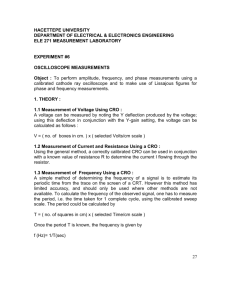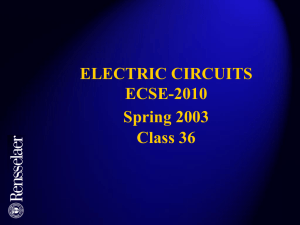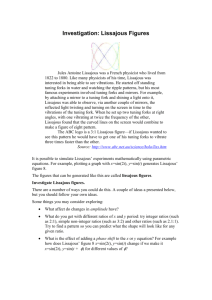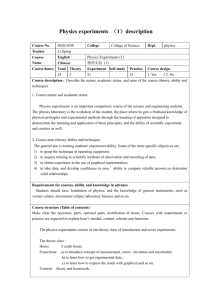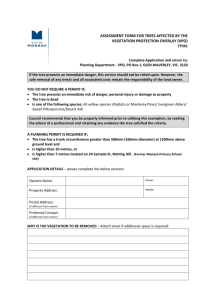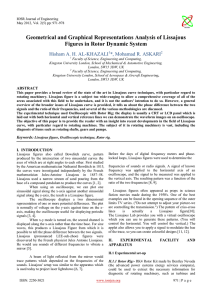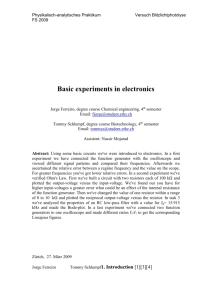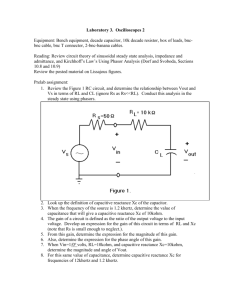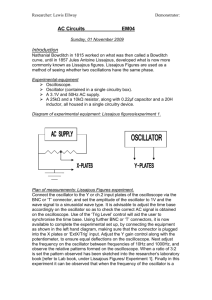ECEN-2611.Lab-11.X2015
advertisement
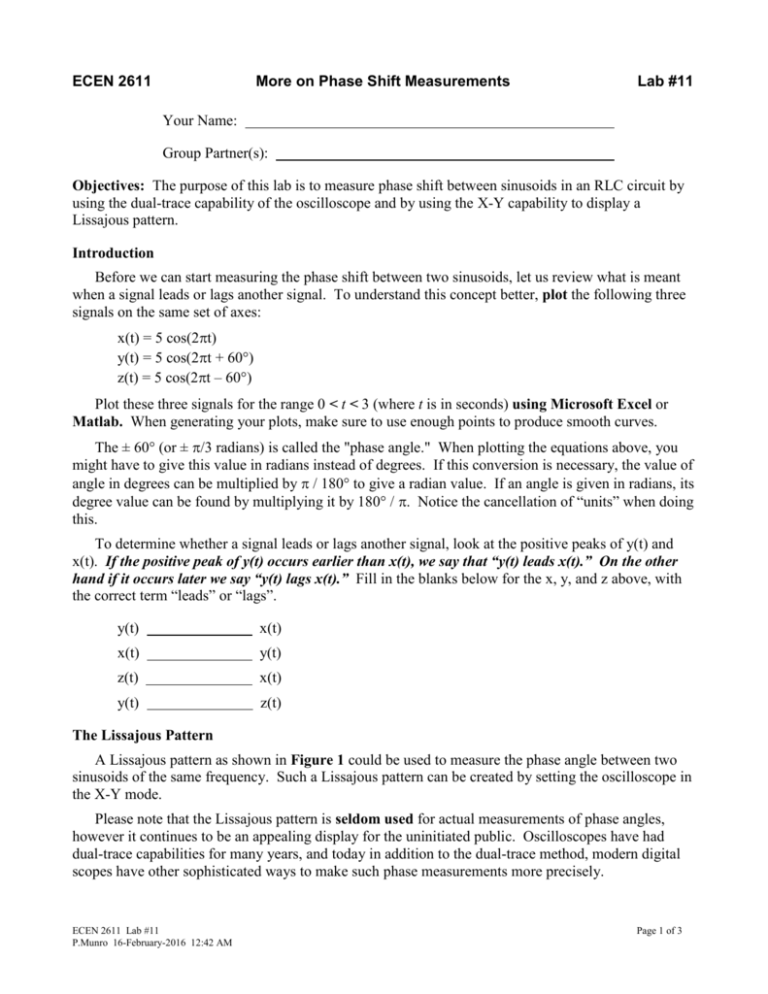
ECEN 2611 More on Phase Shift Measurements Lab #11 Your Name: Group Partner(s): Objectives: The purpose of this lab is to measure phase shift between sinusoids in an RLC circuit by using the dual-trace capability of the oscilloscope and by using the X-Y capability to display a Lissajous pattern. Introduction Before we can start measuring the phase shift between two sinusoids, let us review what is meant when a signal leads or lags another signal. To understand this concept better, plot the following three signals on the same set of axes: x(t) = 5 cos(2t) y(t) = 5 cos(2t + 60°) z(t) = 5 cos(2t – 60°) Plot these three signals for the range 0 < t < 3 (where t is in seconds) using Microsoft Excel or Matlab. When generating your plots, make sure to use enough points to produce smooth curves. The ± 60° (or ± /3 radians) is called the "phase angle." When plotting the equations above, you might have to give this value in radians instead of degrees. If this conversion is necessary, the value of angle in degrees can be multiplied by / 180° to give a radian value. If an angle is given in radians, its degree value can be found by multiplying it by 180° / . Notice the cancellation of “units” when doing this. To determine whether a signal leads or lags another signal, look at the positive peaks of y(t) and x(t). If the positive peak of y(t) occurs earlier than x(t), we say that “y(t) leads x(t).” On the other hand if it occurs later we say “y(t) lags x(t).” Fill in the blanks below for the x, y, and z above, with the correct term “leads” or “lags”. y(t) x(t) x(t) y(t) z(t) x(t) y(t) z(t) The Lissajous Pattern A Lissajous pattern as shown in Figure 1 could be used to measure the phase angle between two sinusoids of the same frequency. Such a Lissajous pattern can be created by setting the oscilloscope in the X-Y mode. Please note that the Lissajous pattern is seldom used for actual measurements of phase angles, however it continues to be an appealing display for the uninitiated public. Oscilloscopes have had dual-trace capabilities for many years, and today in addition to the dual-trace method, modern digital scopes have other sophisticated ways to make such phase measurements more precisely. ECEN 2611 Lab #11 P.Munro 16-February-2016 12:42 AM Page 1 of 3 Figure 1: Lissajous Pattern Figure 2. Typical Lissajous patterns versus phase shift To determine the phase angle between two sinusoids, first measure the two distances C and D as shown in Figure 1. The dimension C is the distance between the two intersections of the Lissajous pattern on the Y-axis. D is the vertical distance between the top and the bottom of the pattern. Compute the phase angle, θ from Equation 1. C 1 A or sin D B sin 1 Equation 1 The sign of the phase angle, θ, cannot be determined directly from the Lissajous pattern. To find the sign of θ, set the scope in the normal time-base mode (not X-Y), and identify whether the waveform of interest is leading or lagging the other signal. If it is leading the other signal, the sign of θ is positive. If it is lagging the other signal the sign of θ is negative. Note two things. We are using the dual-trace method to get the lead/lag. Also note that it is important to use one of the two signals for scope sweep synchronization with the dual-trace method. Experiment A We will begin by measuring and adjusting the phase shift between two sinusoids using the dualtrace capability of the oscilloscope and by using the X-Y capability to display a Lissajous pattern. Begin by setting up the circuit shown in Figure 3. Then, adjust the function generator so that V1 is a 10 V peak, 4.5 kHz, sine wave. Display V1 on channel 1 and VR1 on channel 2 of the oscilloscope. Adjust the horizontal controls so that 1 to 2 periods are displayed. Set the oscilloscope trigger control to trigger on V1 (channel 1). The next step is to adjust the function generator frequency until V1 and VR1 are exactly in phase. Sketch the scope display and label it “At f = f0, VR1 in phase with V1.” At this point measure and ECEN 2611 Lab #11 P.Munro 16-February-2016 12:42 AM Page 2 of 3 record the amplitudes of V1 and VR1. Then measure the period of the waveforms using the scope time base. Once you have the period, you can easily calculate the frequency, which is the reciprocal of the period. Call this frequency f0 and compare it with the generator setting and with the theoretical value of L1 C1 40m 60n V1 VOFF = 0 VAMPL = 10 FREQ = 4.5k R1 3k 0 1 fo Hz 2 LC Equation 2 Figure 3. RLC Circuit Next, we will display a Lissajous pattern using VR1 and V1. For this remember to set the oscilloscope in the X-Y mode. Center the pattern and enlarge it to full-screen size. Sketch the pattern and indicate the values of the overall height, overall width, and the vertical axis intercepts. From the pattern, determine the phase shift of VR1 with respect to V1. Experiment B 1) Set the generator frequency to f0/2 and adjust the horizontal controls to display two periods of V1 and VR1. Sketch the display and label your sketch appropriately. 2) Measure and record the phase shift of VR1 with respect to V1 using the dual-trace mode of the oscilloscope. Label your sketch with the statement "At f0/2, VR1 [leads or lags: choose correctly] V1 by nn degrees", filling in the correct information. Display a Lissajous pattern using VR1 and V1. 3) Sketch the Lissajous pattern and indicate the values of overall height, overall width, and vertical axis intercepts. From the pattern determine the phase shift of VR1 with respect to V1. Experiment C Repeat Experiment B with f = 2f0 and 4f0. Summarize your data for the three different frequencies, f0/2, 2f0, and 4f0, by constructing displays of sketches and tabulation of measurements. Write a discussion of your displays and table entries. Perhaps include the following. a) b) c) d) Sketches of the dual-trace display. Sketches of the Lissajous pattern. The phase shift measurement by the dual-trace method. The phase shift measurement from the Lissajous pattern. Report: Keep a complete record of all data, results, observations, and answers to questions. Due Date: End of Lab Period ECEN 2611 Lab #11 P.Munro 16-February-2016 12:42 AM Page 3 of 3
